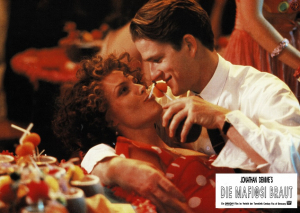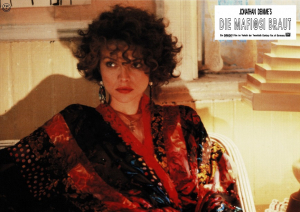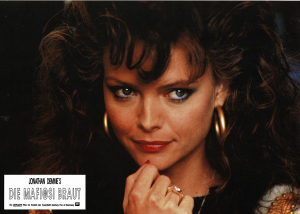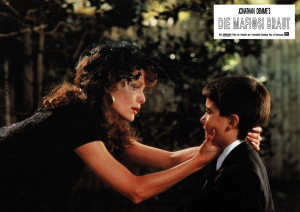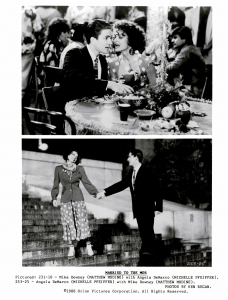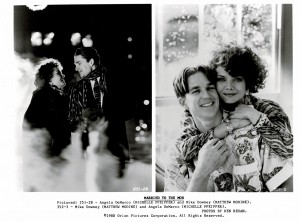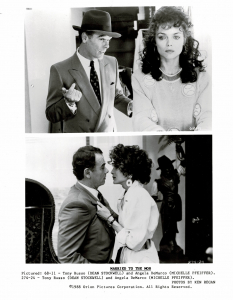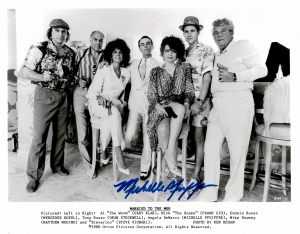Married To The Mob
MARRIED TO THE MOB
Production Information
Angela DeMarco has everything laundered money can buy.
But when her husband leaves for work, she has no idea if he’ll be home for dinner or out on bail. Her Long Island home is decorated in a dazzling diversity of styles, depending on what recently fell off a truck. Her seven-year-old son doesn’t want a toy gun; he knows where Daddy keeps the real thing.
She can’t stand her friends. She hates the life. She wants out.
The opportunity comes with surprising suddenness. When Angela’s husband, Frankie “The Cucumber” DeMarco, ices the “Fat Man” on the 8:10 commuter special out of Mineola, he enjoys the accolades of his business colleagues at the King’s Roost Restaurant. But when he detours to the Fantasia Motel fora quick dip in a Roman bath with cocktail waitress Karen Lutnick, he makes a grievous error in judgment.
Karen is the private property of Frankie’s boss, Tony The Tiger” Russo, who does not take kindly to employee pilfering. The next morning two bodies are found in a tepid hot tub, wearing only identical bullet holes.
Angela is free to start a new life — provided the mob and the FBI will let her.
Michelle Pfeiffer, Matthew Modine and Dean Stockwell star in “Married To The Mob,” an Orion Pictures release of Jonathan Demme picture. Directed by Demme from a screenplay by Barry Strugatz and Mark R. Burns, the dark romantic comedy co-stars Mercedes Kuehl and Alec Baldwin. “Married To The Mob” was produced by Kenneth Utt and Edward Saxon with Joel Simon and Bill Todman, Jr. as executive producers. Music is by David Byrne.
As the young widow who tries to escape the past, Michelle Pfeiffer has what she calls a “dream role.”
“I can identify with Angela,” says the actress. “I think a great many women can. Ever since she came out of high school, married Frankie and had her son Joey, Angela has been told what to do, where to go, how to behave, whom to be nice to. Now she’s taking control of her life, which is both exciting and terrifying.”
That her husband was “connected,” adds director Demme, obviously intensifies the challenge.
“Angela has lived well from blood money. Now she makes a conscious decision that from this moment on, she is going to be good.
That’s not as simple as it sounds. In this day and age, surrounded as we are by corruption on every level, trying to be good can seem crazy to many people.
“We don’t want good people around. They make us look bad. There’s a tremendous pressure to conform to corruption. Those who resist are treated with suspicion.”
Still, Angela DeMarco moves out of her home and gives away its contents to Goodwill (apologizing that she can’t find any sales receipts).
Her next residence is a railroad tenement on New York’s Lower East Side, where the paint is peeling away in chunks, the bathtub is in the kitchen and the windows overlook the street — completely — in favor of an air shaft.
In the words of Tony Russo, who has traced her from Long Island, the apartment is “a real shithole.” Tony is confused. Angela obviously finds him attractive; all women do. And since he put the make on her, even before he cooled off The Cucumber, why won’t she accept his well- known generosity?
FBI agent Mike Downey is equally baffled. Armed with surveillance photos of Angela and Tony in a passionate clinch at Frankie’s wake, he has persuaded his superiors to let him tail the widow DeMarco and “catch Tony with his pants down.” But the last place he expected the stake-out to take him was a roach-ridden firetrap on Rivington Street.
He must move in closer, perhaps use his mastery of disguise. Thus it is that Angela DeMarco encounters “Mike Smith,” a flu-ridden handyman, in the graffiti-scarred elevator of the tenement building.
Matthew Modine, who plays Downey, describes the G-man as a “woeful misjudge of character.” He doesn’t know that when Tony embraced Angela after the funeral, she was caught by surprise — and revolted. As she takes her son to school and searches desperately for a job, he sees an ulterior motive in every move she makes. Is she running numbers Making a drop? Hustling crack? What’s coming down?
“Then he gets to know her,” says Modine, “and everything turns inside out. He tries to sabotage the investigation he started in the first place. He dismantles his own phone bugs, files false reports, leads a double life. “Finally, he informs his superiors that Angela is innocent. They don’t want to know. They prefer his original theory, even if it’s wrong.
They order him to step up the pressure on Angela — and nail her.”
Modine, who describes “Married To The Mob” as a “sardonic romantic comedy,” admits he’s attracted to “roles which force me into areas I know nothing about.” Thus, a lunch was set with a veteran police detective (“Jonathan Demme’s cousin’s husband,” he recalls) to discuss the fine points of undercover sleuthing. “It was fascinating,” he says.
Writers Barry Strugatz and Mark R. Burns, devoted considerable research to their first produced screenplay. A film editor and location scout respectively, they sat in on mob trials in Brooklyn and New York to “assimilate a sense of today’s underworld and the arrogance of people like Tony Russo,” says Strugatz. “Some of the hoods are pretty close to life, but we’ve changed the names to protect ourselves.”
Adds Burns: “The current generation of gangsters isn’t confined to the mean streets. They’re people who live next door to you in suburbia. They’re very much into equal opportunity.”
The writers brought the screenplay to the production partnership of Joel Simon and Bill Todman, Jr., whose two-year teaming has sparked some ten projects in development with major studios.
“It was refreshing to find a comedy which grew out of character . . . and had its own quirky viewpoint,” says Todman. Equally gratifying, he goes on, was that when Orion Pictures bought the property, “everyone agreed that Jonathan Demme should direct it, provided, of course, that he shared our enthusiasm.” He did. Demme’s feeling for the gangster genre dates back to his origins as a youthful movie critic who crossed over into filmmaking with Roger Corman.
“I’ve never known whether the classic gangster portraits of actors like Humphrey Bogart, Edward G. Robinson and George Raft were based on actual hoodlums or if the mobsters took their cues from the movies,”
Demme observes. “Probably a little of both.”
But in any case, the era of ‘Little Caesar’ and ‘Public Enemy’ seems centuries away. The filmmakers found in their research that today’s upwardly-mobile gangster lives comfortably and discreetly in the stockbroker belt. As far as the neighbors (and the IRS) are concerned, he’s the senior vice president of Acme Toxic Waste Removal or the South Shore Cement Works. His 2 3 kids go to school in the station wagon. His wife is active in the PTA. On Sunday afternoons, there are backyard barbecues.
The onus on the families of upscale hoods is to keep up a respectable facade, adds actress 0-Lan Jones. As one of a quartet of mob wives, she explains, “I can’t be bothered by things like extortion, gambling, prostitution and murder. My husband takes care of business. Mainly, I keep house.”
As Tony Russo’s wife Connie, however, Mercedes Ruehl confronts a common hazard of the sybaritic suburbs, a cheating husband.
Her response, depending on her mood swings, is to “be so warm and loving that Tony will have no desire to stray, or to do something nasty to his private parts which will ultimately have the same effect,” says Ruehl. “Connie makes Medea look mild-mannered.” Adds director Demme:
“Mercedes brings an operatic passion to the role.”
A classically-trained actress, Ruehl developed an accent which she describes as “affluent Long Island, two generations removed from the slums of Bensonhurst.” It was achieved, she explains, “by speaking mostly with the lower lip, moving the top lip as little as possible so it doesn’t get wrinkles.”
Demme cast Dean Stockwell as Tony Russo, he says, after running across a photo of the actor in a trade paper ad. “I’d always loved his work,” recalls the director. “Looking at Dean’s picture in the Hollywood Reporter,
I felt then — with great excitement — that Tony “The Tiger” was sneering back at me.
Stockwell, now deep into his “third career” as a character actor (after childhood stardom and youthful roles in films like “Compulsion” and “Long Day’s Journey Into Night”), describes Tony “The Tiger” as a “charming, personable guy with legitimate business interests and a way with women.” Wearing an Alphonse Capone fedora and an ankle-length yellow coat for which a colony of vicunas made the ultimate sacrifice, he tells a visitor to the New York location: “That’s my story. I hope you agree, because you seem to have a nice, useful set of kneecaps.”
Extricating his tongue from his cheek, Stockwell adds: “If I played this same character in a super-realistic gangster film, he’d be a lot darker.
And I wouldn’t be having nearly as much fun.”
To producer Edward Saxon, who collaborated with Demme on “Something Wild” and “Swimming to Cambodia,” the humor of “MarriedTo The Mob” is rooted in paradox. “The cold-blooded routine of the Mafia, dealing drugs, dumping toxic waste, wanton murder, is in striking contrast to their strong family values,” he points out. “Think of the phrase, ‘kiss of death.’ Could anything be more ironic’?”
Producer Kenneth Utt, who has roamed New York with sound gun and camera as associate producer of films like “Midnight Cowboy,” The French Connection” and “All That Jazz,” calls “Married To The Mob” “one of the toughest shoots I’ve been involved in. The script was loaded with short scenes in tricky locations throughout Manhattan, Long Island and eventually Miami, which had to be brought in on a realistic budget.”
The pressure might have been eased, Utt goes on, if Demme had succumbed to “lower bids” to film the story outside New York or utilize studio interiors.
Instead, “only one set was constructed for the entire film,” notes production designer Kristi Zea. “For the murder of Alec Baldwin as Frankie DeMarco in the Pantheon Room of the Fantasia Motel, it was necessary to flood the set.” When the risk of water damage made movie immortality an offer any innkeeper could refuse, “we built a swimming pool under a sound stage, then installed the motel room above it,” says the designer.
Otherwise, the crew took to the streets, always open to serendipity.
Recalls associate producer Ron Bozman: “At one point, we encountered a wonderful street musician known as ‘Mr. Spoons.’ Jonathan was entranced, and Mr. Spoons is in the picture.” Manhattan’s pulsating Lower East Side, in the shadow of the ancient Williamsburg Bridge (which would be closed to traffic within a few months when its beams seemed in imminent danger of collapse), proved a colorful, ethnically diverse backdrop for Angela DeMarco’s “new life.”
It is also a neighborhood with a soaring crime rate, notes location manager Steve Rose. “We took elaborate security precautions. Still, the caterer turned his back for just a few minutes and when he returned the coffee bar was missing. How do you hock a 40-gallon coffee urn?”
Nearby on Centre Street, art and life collided when the camera crew’s dolly track overlapped the entrance to the federal courthouse.
Although it was late at night and the building was deserted, the unit was confronted by armed officers who politely — but firmly — suggested that filming on federal property would be frowned upon.
Throughout the location-scouting process, continues Rose, negotiations were conducted in a mixture of tongues — including Spanish, Chinese, Korean and sign language — with merchants who spoke little English. Among the prized sites was the Solidaridad Humana Community Center, converted from an old schoolhouse, where Mike Downey and Angela DeMarco celebrate their first date by joining a spirited “Cuando” dance.
With the live music of the Brazilian powerhouse samba band, Pe de Boi, for encouragement, the requisite number of takes was completed.
Then the cast and crew stayed on, joined by friends, relatives, extras and local residents, for a storm of samba that continued well into the night. Such rhythms are important to Demme, a respected ethno- musicologist, whose work has included the trend-setting concert film, “Stop Making Sense,” and music videos in a wide range of idioms.
Among some 50 songs scattered through the soundtrack of “Something Wild” was the closing theme, “Wild Thing,” performed by reggae star Sister Carol. Delighted by that performance, he offered the Jamaican-born singer a co-starring role in “Married To The Mob.” As Rita, the soulful proprietress of the Hello Gorgeous beauty shop, she befriends Angela, incurring the wrath of the FBI — and landing on the hit list of the INS.
Other cast members drawn from contemporary music include rocker David Johansen (alias Buster Poindexter), a winner of seven top honors at the 1986 New York Music Awards, led by Best Male R&B Vocalist, and Chris Isaak, whose “Dancint” video caught Demme’s eye.
Johansen plays a Mafia priest, while Isaak, described by Demme as a “minor-key mix of Elvis Presley and Roy Orbison,” is seen as a hit man
Even music supervisor Gary Goetzman, who produced “Stop Making Sense,” puts in a cameo appearance — as the lounge pianist at Tony Russo’s favorite hangout who sings a simpering tribute to the big-tipping “Tiger.”
Under Goetzman’s supervision, the soundtrack features songs by exciting newcomer Jane Child and Q. Lazzarus, who introduced Demme to her ballad, “Transformation,” when he rode as a passenger in her taxicab.
One last musical contribution merits mention. When Matthew Modine tracks Michelle Pfeiffer through the Lower East Side, he briefly, bu tenthusiastically, joins a troupe of street musicians — portrayed by the doo- wop group, True Image — rather than blow his undercover cover.
Describing such scenes, Pfeiffer says that she frequently “felt like the Martin Sheen character in ‘Apocalypse Now.’ I was trying to be straight, and here were all these wild characters, doing crazy things around me.”
To personify that spirit, says casting director Howard Feuer, he joined Demme in “avoiding the obvious, taking a step or two to the right or left.” Included in key roles are Alec Baldwin (almost unrecognizable from the ghostly innocent he plays in “Beetlejuice”) as ambitious gunsel Frankie DeMarco; Oliver Platt, an alumnus of the Manhattan Punch Line Theatre Group (where he was spotted — and recommended to Demme — by Bill Murray), as junk-food addict G-man Ed Benitez; and Paul Lazar (of the avant-garde Irondale Ensemble) as Tony Russo’s wiry bodyguard, Tommy.
The proprietor of the mob wives’ makeshift forum, the Chez Ray Beauty Salon, is played by Charles Napier, who has appeared in all of Demme’s films since “Handle With Care.” Another favorite actor, Tracey Walter, is the manager of the Chicken Lickin’ fast-food franchise where Angela DeMarco is introduced to sexual harassment in the workplace — and the job interview.
While veteran character actor Trey Wilson plays Mike Downey’s relentless FBI boss, Franklin, his tough-talking aide (in an unbilled cameo) is producer Kenneth Utt.
Cinematographer Tak Fujimoto, in his seventh collaboration with Demme, notes that the film’s satirically colorful characters to some degree dictated his own approach. “Mostdirectors want realism,” he explains. ” But for the mob war between rival thugs, for example, we shied away from graphic violence in favor of melodramatic shadows and silhouettes. The lighting style had to match the acting style.”
So, too, did the garish and exotic locations which mirrored the mobsters’ taste in pop culture. “Some people were reluctant to lease their homes — or mansions — to us when they heard the title,” admits Kenneth Utt. On the other hand, the LongIsland Railroad had no qualms about providing a commuter train for the film’s opening gangland execution.
“Anywhere but New York, we’d have been in trouble,” Utt explains.
“But the Long Island Railroad knew that people would accept it as fiction and that nothing we did could tarnish its image.”
